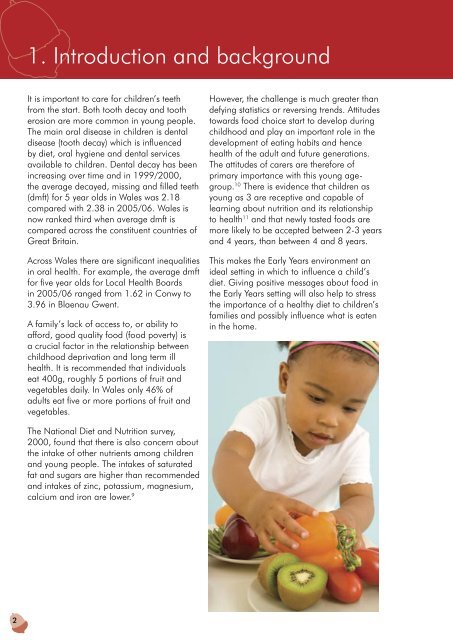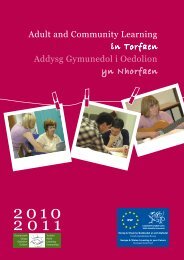Food and Health Guidelines - Torfaen Family Information Service
Food and Health Guidelines - Torfaen Family Information Service
Food and Health Guidelines - Torfaen Family Information Service
Create successful ePaper yourself
Turn your PDF publications into a flip-book with our unique Google optimized e-Paper software.
1. Introduction <strong>and</strong> background<br />
It is important to care for children’s teeth<br />
from the start. Both tooth decay <strong>and</strong> tooth<br />
erosion are more common in young people.<br />
The main oral disease in children is dental<br />
disease (tooth decay) which is influenced<br />
by diet, oral hygiene <strong>and</strong> dental services<br />
available to children. Dental decay has been<br />
increasing over time <strong>and</strong> in 1999/2000,<br />
the average decayed, missing <strong>and</strong> filled teeth<br />
(dmft) for 5 year olds in Wales was 2.18<br />
compared with 2.38 in 2005/06. Wales is<br />
now ranked third when average dmft is<br />
compared across the constituent countries of<br />
Great Britain.<br />
Across Wales there are significant inequalities<br />
in oral health. For example, the average dmft<br />
for five year olds for Local <strong>Health</strong> Boards<br />
in 2005/06 ranged from 1.62 in Conwy to<br />
3.96 in Blaenau Gwent.<br />
A family’s lack of access to, or ability to<br />
afford, good quality food (food poverty) is<br />
a crucial factor in the relationship between<br />
childhood deprivation <strong>and</strong> long term ill<br />
health. It is recommended that individuals<br />
eat 400g, roughly 5 portions of fruit <strong>and</strong><br />
vegetables daily. In Wales only 46% of<br />
adults eat five or more portions of fruit <strong>and</strong><br />
vegetables.<br />
However, the challenge is much greater than<br />
defying statistics or reversing trends. Attitudes<br />
towards food choice start to develop during<br />
childhood <strong>and</strong> play an important role in the<br />
development of eating habits <strong>and</strong> hence<br />
health of the adult <strong>and</strong> future generations.<br />
The attitudes of carers are therefore of<br />
primary importance with this young agegroup.<br />
10 There is evidence that children as<br />
young as 3 are receptive <strong>and</strong> capable of<br />
learning about nutrition <strong>and</strong> its relationship<br />
to health 11 <strong>and</strong> that newly tasted foods are<br />
more likely to be accepted between 2-3 years<br />
<strong>and</strong> 4 years, than between 4 <strong>and</strong> 8 years.<br />
This makes the Early Years environment an<br />
ideal setting in which to influence a child’s<br />
diet. Giving positive messages about food in<br />
the Early Years setting will also help to stress<br />
the importance of a healthy diet to children’s<br />
families <strong>and</strong> possibly influence what is eaten<br />
in the home.<br />
The National Diet <strong>and</strong> Nutrition survey,<br />
2000, found that there is also concern about<br />
the intake of other nutrients among children<br />
<strong>and</strong> young people. The intakes of saturated<br />
fat <strong>and</strong> sugars are higher than recommended<br />
<strong>and</strong> intakes of zinc, potassium, magnesium,<br />
calcium <strong>and</strong> iron are lower. 9<br />
2

















